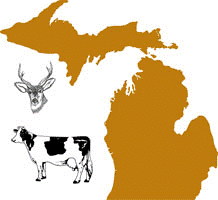Wildlife Disease and Zoonotics
Date of this Version
2007
Citation
in Summaries of Wildlife Research Findings 2007, pp. 1–9, Minnesota Department of Natural Resources, Wildlife Population and Research Unit, St. Paul, Minn, USA, 2008.
Abstract
Bovine tuberculosis (TB), first discovered in 2005, has now been found in 11 cattle operations in northwestern Minnesota. To date, all of the infected cattle herds have been depopulated and the Board of Animal Health (BAH) has continued an investigation of herds in the area as well as conducted a statewide surveillance effort. The strain has been identified as one that is consistent with bovine TB found in cattle in the southwestern United States and Mexico. In November 2007, the Minnesota Department of Natural Resources (MNDNR) conducted bovine TB surveillance of hunter-harvested white-tailed deer (Odocoileus virginianus) within a 15-mile radius of the infected farms. Results indicated that 5 of the 1,085 deer tested positive for bovine TB; estimated disease prevalence of 0.46% (SE=0.2%). All infected deer were harvested within 5 miles of Skime, Minnesota, which is in close proximity to 7 of the infected livestock operations. In response to additional deer found infected with bovine TB since 2005, the MNDNR also conducted a targeted deer removal operation during winter 2007, using sharpshooters from the United States Department of Agriculture (USDA) Wildlife Services. An additional 488 deer were removed through this project, yielding 6 more cases of infected deer. Further, a recreational feeding ban, covering 4,000 mi2 in northwestern MN, was instituted in November 2006 to help reduce the risk of deer to deer transmission of the disease and enforcement officers have been working to stop illegal feeding activities. Also, in 2006, the Minnesota State Legislature passed an initiative that allocated $54,000 to deer-proof fencing materials for livestock producers within 5 miles of a previously infected farm; MNDNR erected 15 fences on 11 cattle premises during summer 2007. The findings of additional infection in cattle herds as well as the deer has resulted in the downgrading of Minnesota’s bovine TB status to “modified accredited”, which has increasing testing requirement for cattle statewide. The MNDNR will continue to conduct hunter-harvested surveillance in fall 2008 to monitor infection in the local deer population, and consider the continuation of aggressive management actions (e.g., sharpshooting deer in key locations) to address concerns of deer becoming a potential disease reservoir.


